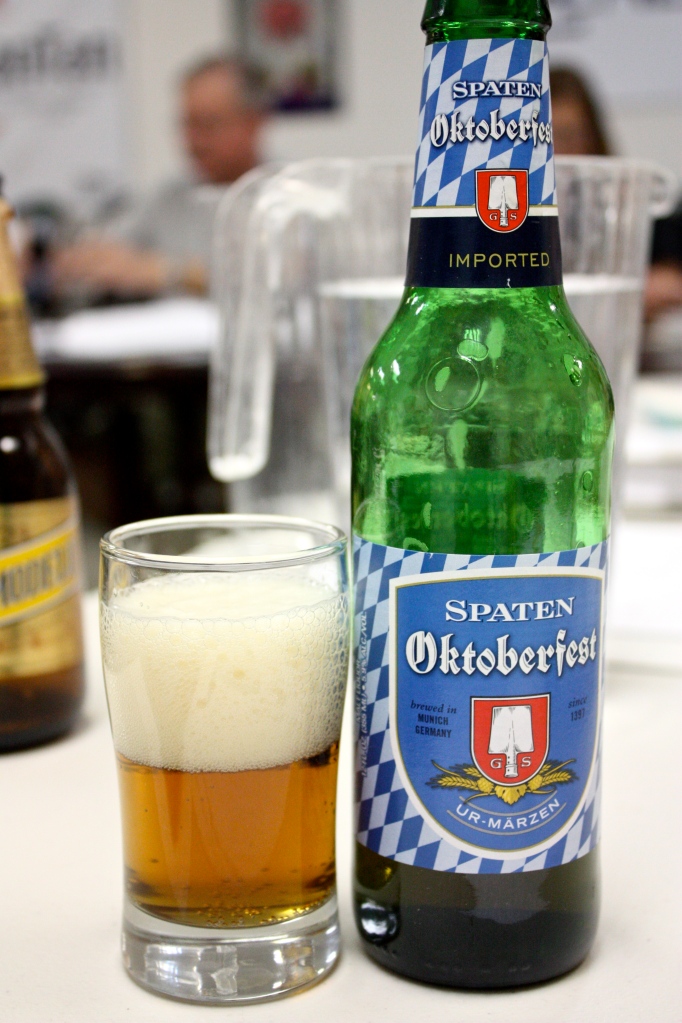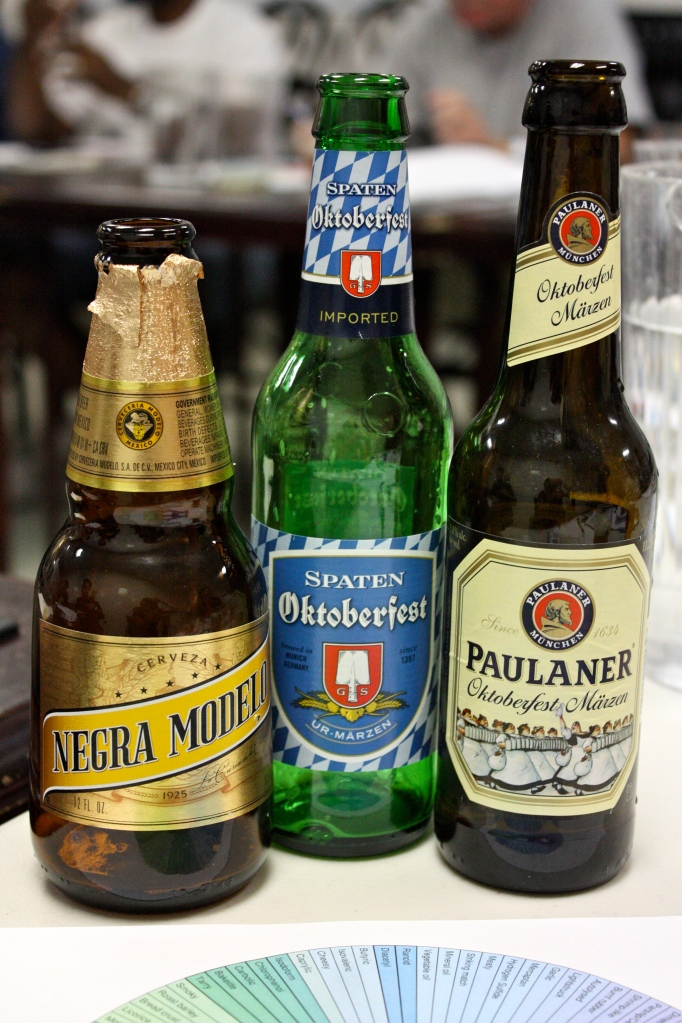BJCP Class #3 – Sensory Vocabulary & Style 3: European Amber Lager
Not even week 3 and I’ve already fallen behind. Work events are starting to come in waves, and I’ve been attending beer dinners, festivals, and promos like crazy. Not to mention, I spent all day Saturday volunteering behind the scenes at a beer judging that went about as smoothly as a ship in a hurricane. Nevertheless, I’m going to speed through this one so I can at least get it out there and not have to worry about catching up twice over since I have my 5th class tonight!
At the beginning of class, we were given multiple sheets with appropriate descriptors for each of the judging categories, different aspect examples for aroma, appearance, flavor, mouthfeel, and overall impression, and a flavor/aroma wheel in order to learn which words might best describe what it is we’re experiencing in a particular beer. For example, if you perceive a beer to smell or taste fruity, you need to figure out which fruit it reminds you of (especially if it’s not supposed to have any fruit in it). Your most common choices are acetaldehyde (green apple), apple, pear, citrus, strawberry, melons, banana, etc. More uncommon choices are black currant, raspberry, peach, and mango. You might want to describe whichever fruit you’re experiencing as perfumy, sour, cloying, or even syrupy. Some other common categories to pull descriptors from include: vegetal (woody, piney, nutty – walnut, almond, etc – coconut, fresh grass), cereal (straw, corn, mealy, malty), maillard (licorice, smoky), sulfury (meaty, vegetable oil, garlic, lightstruck, cooked cabbage/sweet corn/tomato), or stale (papery, leathery, earthy, musty). There is really no limit to what descriptors you can use, and if the beer you’re judging reminds you of something from your childhood, write it down! No beer will be judged by the exact same personal criteria, and what you might perceive as bacon, someone else might be perceive as the smell of the plastic swing set they grew up playing on when it sat in the sun for too long.
While flavor and aroma are fairly free in the rules department, there are specific color guidelines that should be referenced when judging appearance. The head can be a little more difficult, since it really depends on your pour (tip: pour vigorously to ensure a strong starting head that will allow you time to look it over as it dissipates). Appropriate color descriptions vary across 12 SRM valuations ranging from 2 to 40+ and are grouped together based on what is acceptable for each style. Options include straw, yellow, gold, amber, deep amber/light copper, copper, deep copper/light brown, brown, dark and very dark brown, black, and opaque. For judging, there are special additives that may be mixed in a lighter beer to make it appear darker to throw you off (as well as added legitimately during the brewing process to better fit a beer into the style), but I’ll cover that next time.
Then there’s mouthfeel, which is commonly mistaken with flavor and occasionally the two become interchangeable for some people. What you feel on your tongue and throughout your mouth is NOT what you are tasting. If something is sour, it is a flavor. If something is astringent or puckering or cloying, it is mouthfeel. What you physically feel when your taste buds recognize something sour is mouthfeel. For me, the biggest issue I have is that some of the words you can use for mouthfeel are also acceptable as descriptors for flavor (something can be cloyingly sweet). Just make sure you remember to include adjectives you’re not sure about in both areas on a scoresheet. Also of note, carbonation is not a flavor…it is a mouthfeel.
I’ll save flaws for another week, since they can apply to any beer.
Style 3A – Vienna Lager. For the example, we sampled Negra Modelo. My notes:
- Aroma – Spicy from hops, toasted malts, faint fruitiness (possibly apple or pear)
- Appearance – deep amber to light copper, off-white head, bright clarity
- Flavor – malty sweetness, not as dry as a pilsner, but still soft and clean. Balanced finish with no overpowering hops or malt. No caramel flavors, minimal toasted flavors
- Mouthfeel – medium-light body, gentle creaminess, moderate carbonation, smooth
 Style 3B – Oktoberfest/Märzen. For the example, we sampled Spaten Oktoberfest. (Oktoberfests are generally higher in ABV, darker, sweeter, and lower in hop profile than Viennas) My notes:
Style 3B – Oktoberfest/Märzen. For the example, we sampled Spaten Oktoberfest. (Oktoberfests are generally higher in ABV, darker, sweeter, and lower in hop profile than Viennas) My notes:
- Aroma – rich, sweet, toasty malt, no hops, no fruitiness, no caramel. Clean lager aroma
- Appearance – deep amber with gold highlights, bright clarity, solid off-white head
- Flavor – much more hop bitterness from the beginning, light carbonation, cardboard ending, a lot of malt
- Mouthfeel – light-medium (and apparently I didn’t think much more about it, because that’s all I wrote)
 Style 3B (part 2) – Oktoberfest/Märzen. For the example, we sampled Paulaner Oktoberfest Märzen. (We were told that Märzens were traditionally brewed in March in order to be enjoyed in the fall) My notes:
Style 3B (part 2) – Oktoberfest/Märzen. For the example, we sampled Paulaner Oktoberfest Märzen. (We were told that Märzens were traditionally brewed in March in order to be enjoyed in the fall) My notes:
- Aroma – bready, biscuity maltiness, no hop aroma, no fruity esters, completely appropriate for style
- Appearance – gold-amber color, bright clarity, white head with a little bit of lacing
- Flavor – bitter aftertaste, moderate malty sweetness, bready and lightly toasty. No esters, minimal to no hop flavor, but spiciness is present
- Mouthfeel – medium carbonation, medium body with slight creaminess




